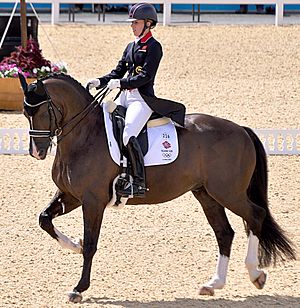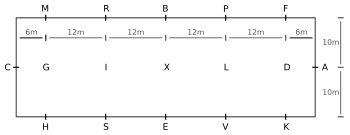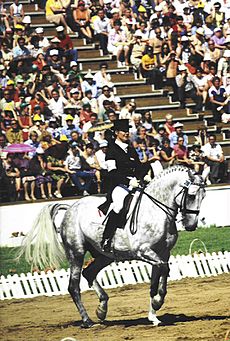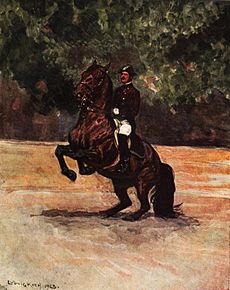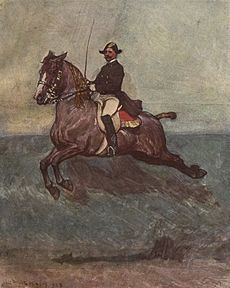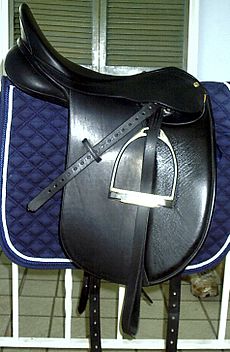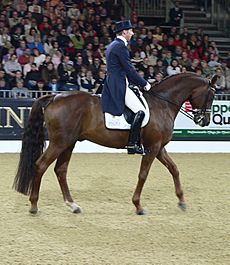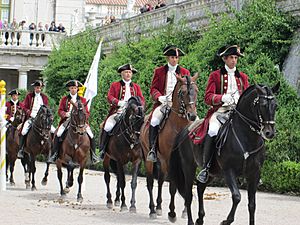Dressage facts for kids
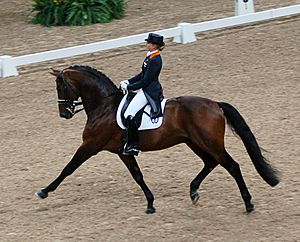
An upper-level dressage competitor performing an extended trot
|
|
| Highest governing body | International Federation for Equestrian Sports (FEI) |
|---|---|
| Characteristics | |
| Contact | No |
| Team members | Individual and team at international levels |
| Mixed-sex | Yes |
| Equipment | Horse, appropriate horse tack |
| Venue | Arena, indoor or outdoor |
| Presence | |
| Country or region | Worldwide |
| Olympic | 1912 |
| Paralympic | 1996 |
Dressage (pronounced "dress-ahj") is a special way of training horses. It's like a beautiful dance between a horse and its rider. The word "dressage" comes from French and means "training."
In dressage, horses learn to perform many different movements from memory. They do this in a special arena. The goal is to make the horse look graceful and easy to ride. The rider gives very small signals, and the horse responds smoothly. It's often called "the highest expression of horse training."
Dressage has a long history. It started with ancient Greek writings by a man named Xenophon. Modern dressage became popular during the Renaissance. Today, it is an equestrian sport. It is even part of the Olympic Games and World Equestrian Games.
Contents
- What is a Dressage Horse?
- The Dressage Arena
- How Dressage is Judged
- Dressage Competitions
- International Level Dressage
- The Dressage Training Scale
- "Airs" Above the Ground
- Famous Dressage Masters
- Horse Tack for Dressage
- How Dressage Horses Look for Competition
- What Dressage Riders Wear
- Images for kids
- See also
What is a Dressage Horse?
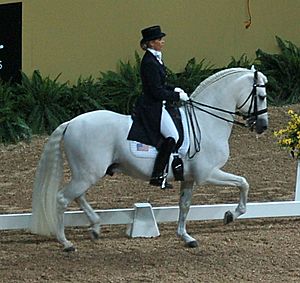
The horses you see in big dressage competitions, like the Olympics, are usually special breeds. These are often warmblood horses. They are bred to be good at dressage.
Some older styles of dressage, called "classical dressage," use different horses. These are often "baroque" breeds. Examples include the Andalusian or Lipizzan horses. These breeds are strong and good at special moves like the "airs above the ground."
The Dressage Arena
Dressage competitions happen in a special riding area called an arena. There are two main sizes: small and standard. Both have letters placed around the edges. These letters tell riders where to perform specific movements.
Small Arena Details
The small arena is 20 by 40 meters (about 66 by 131 feet). It's used for lower-level competitions. The letters around it, starting from the entrance (A) and going clockwise, are A-K-E-H-C-M-B-F. There are also letters along the middle line of the arena.
Standard Arena Details
The standard arena is 20 by 60 meters (about 66 by 197 feet). This size is used for most pure dressage and eventing competitions. The letters are A-K-V-E-S-H-C-M-R-B-P-F. The horse enters the arena at the letter A.
How Dressage is Judged
In dressage, judges watch each horse and rider. They give scores for each movement. The scores range from zero (not done) to ten (excellent). A score of 9 is very good! If a rider gets mostly 6s (or 60%), they are doing well enough to try harder levels.
For big competitions, there can be up to seven judges. They sit in different spots around the arena. This helps them see every movement from all angles. It makes sure nothing is missed.
Dressage Competitions
Dressage competitions have different levels. Each level gets harder. The highest level is called "Grand Prix." This is what you see at the Olympic Games and other big international events.
Lower levels teach basic skills. Horses learn simple gaits (walk, trot, canter) and large circles. As they get better, they learn more difficult moves.
Besides competitions, there's also "classical dressage." This is about keeping old training traditions alive. Famous schools like the Spanish Riding School in Vienna, Austria, practice this art form.
Dressage Tests
Dressage tests are a set of specific movements. Horse and rider perform these movements in a certain order. They are judged against a standard, not directly against other riders.
Each part of the test gets a score from 0 to 10:
- 10: Excellent
- 9: Very good
- 8: Good
- 7: Fairly good
- 6: Satisfactory
- 5: Marginal
- 4: Insufficient
- 3: Fairly Bad
- 2: Bad
- 1: Very bad
- 0: Not executed
Judges can also add comments to explain their scores. Some movements are extra important. They get a higher score if done well. This is called a "coefficient."
What is Scribing?
Scribing is when someone writes down the judge's scores and comments. This helps the judge focus on watching the horse. Scribes need to know dressage terms and have neat handwriting. It's a great way to learn more about judging!
International Level Dressage
At the international level, the highest tests are called Grand Prix. These tests require amazing skill from both horse and rider.
Here are some movements you might see in a Grand Prix test:
- Piaffe: The horse trots in place, lifting its legs high. It looks like a trot, but without moving forward much.
- Passage: This is a very collected trot. The horse lifts its legs high and seems to pause in the air between steps.
- Extended Gaits: The horse stretches its strides as long as possible. This shows great power and reach, especially at the trot and canter.
- Collected Gaits: The horse shortens its strides but keeps the same energy. It brings its hind legs more under its body.
- Flying changes in Sequence: The horse changes its canter lead every one, two, three, or four strides. These are often called "tempis."
- Pirouette: The horse turns in a full circle (360 degrees) in place, usually at the canter.
- Half-pass: The horse moves diagonally across the arena. It moves sideways and forward at the same time, bending slightly in the direction it's going.
At the Olympics, seven judges score the Grand Prix tests. The scores are turned into percentages. The higher the percentage, the better! Teams win medals based on their combined scores. Then, individual riders compete for their own medals. The final individual competition is called the Grand Prix Freestyle to Music. Riders create their own routines to music.
The Dressage Training Scale
Dressage training follows a special "training scale." It's like a pyramid with six steps. Each step builds on the one before it. A horse needs to be good at the lower steps before moving to the higher ones.
Rhythm and Regularity
This is the first step. It means the horse's gaits (walk, trot, canter) should be steady and even. The horse should keep the same rhythm and tempo. This is important on straight lines and turns.
Relaxation
The second step is relaxation. A relaxed horse will move smoothly. Its back will swing, and its tail might swing like a pendulum. The horse will also chew softly on the bit and breathe calmly.
Contact
Contact is the connection between the rider's hands and the horse's mouth through the reins. It should be light and even. The horse should stretch forward into the rider's hands, not be pulled back.
Impulsion
Impulsion is the horse's forward power. It's the energy that comes from the horse's hind legs pushing forward. A horse with good impulsion is eager to move forward. It also uses its body correctly.
Straightness
A horse is straight when its hind legs follow exactly where its front legs go. This is true on straight lines and on curves. Straightness helps the horse use its power evenly. A common exercise for this is called 'shoulder-in'.
Collection
Collection is the top of the pyramid. It means the horse carries more weight on its hindquarters. The horse's hind legs bend more, allowing it to lift its front end. This makes the horse feel lighter and more agile. Collection requires a lot of strength and training.
"Airs" Above the Ground
The "airs above the ground" are very advanced classical dressage movements. In these moves, the horse actually leaves the ground! They include the capriole, courbette, and levade. You won't see these in modern competitions. But they are performed by special riding schools, like the Spanish Riding School.
These moves were once thought to be for military use. However, they were more likely exercises to make horses stronger and more agile. Baroque horse breeds like the Andalusian and Lipizzan are often trained for these difficult "airs."
Famous Dressage Masters
Many people have helped shape dressage over time. The ancient Greek general Xenophon wrote about horse training over 2000 years ago. Later, during the Renaissance, trainers like Federico Grisone and Antoine de Pluvinel wrote important books. Their ideas still influence dressage today.
Horse Tack for Dressage
Dressage horses wear special equipment called "tack." The rules for tack can change. Tack is usually black leather.
Dressage Saddle
Riders use a special "dressage saddle." It has a long, straight flap. This helps the rider keep their leg long and still. The saddle also has a deep seat. It is usually placed over a white square saddle pad.
Bridle and Bit
The bridle holds the bit in the horse's mouth. At lower levels, horses wear a simple snaffle bit. This bit has a joint in the middle. At higher levels, horses use a double bridle. This has two bits: a snaffle and a curb bit. The curb bit helps with more advanced movements.
How Dressage Horses Look for Competition
Dressage horses are turned out very neatly for competitions. Their manes are braided (also called plaited). The braids are held with yarn or rubber bands. The horse's tail is usually not braided. It is cut straight across, usually above the fetlocks.
The horse's face and legs are often trimmed. Their hooves might be polished. Sometimes, you'll see foam around the horse's mouth. This is often a sign that the horse is relaxed and accepting the bit.
The horse's appearance does not affect its score. But it shows respect for the sport.
What Dressage Riders Wear
Dressage riders also dress formally. They wear white or light-colored breeches (riding pants). They have a white shirt and a stock tie with a small pin. Gloves are usually white.
Riders wear a black or navy coat. For upper-level classes, they wear a special long-tailed jacket called a "shadbelly." They also wear tall dress boots. Spurs are required at higher levels. A whip can be carried in most competitions, but not at the Olympics.
Riders with long hair usually put it in a bun with a hair net. For head protection, junior riders must wear an approved Equestrian helmet. At the highest levels, riders traditionally wear a top hat. However, helmets are becoming more popular.
Images for kids
See also
 In Spanish: Doma clásica para niños
In Spanish: Doma clásica para niños
- Equestrianism
- Classical dressage
- Para-equestrian


